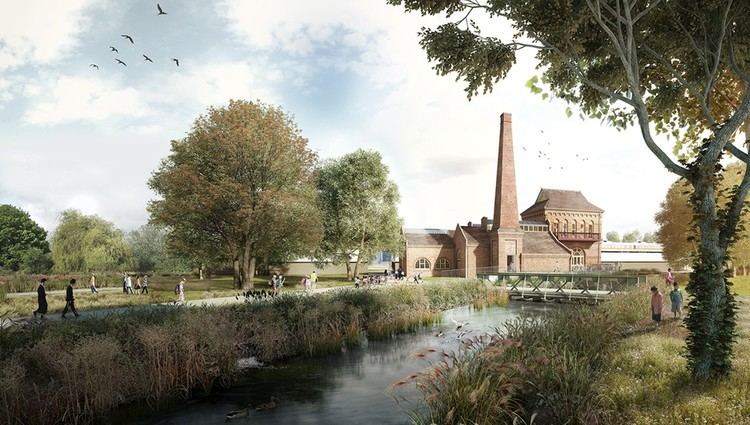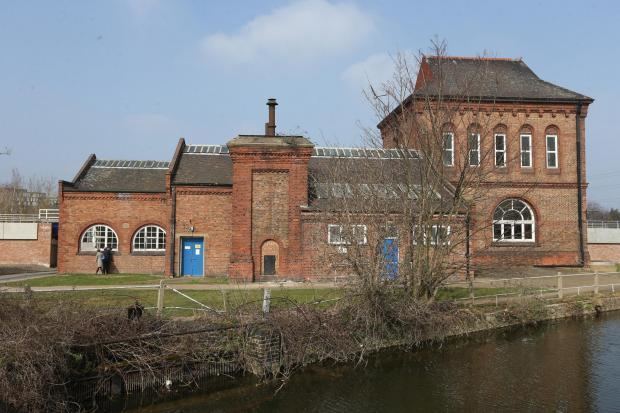Grid reference TQ350893 Location map Magic Map | Interest Biological Area 211 ha | |
 | ||
Walthamstow Wetlands is a 211 ha (520 acres; 2.11 km2) nature reserve, currently under development at Walthamstow Reservoirs, in north east London. Due to open in 2017, the site is particularly important for wildlife due to its position within the Lee Valley; a byway for migrating, wintering and breeding birds in the Greater London area.The site is designated as a Site of Special Scientific Interest (SSSI) and once completed will be one of the largest urban wetland nature reserves in Europe. Visitors will be able to freely access the site’s unique natural, industrial and social heritage in one of the capital’s most diverse and densely populated urban areas.
Contents
- Inside the marine engine house at walthamstow wetlands pre renovation
- History
- The Marine Engine House
- The Coppermill
- Ecology
- Access
- References

The reservoirs, under the ownership of Thames Water, also form part of a larger Site of Metropolitan Importance for Nature Conservation, noted for the mixture of aquatic and terrestrial habitats on site, and for their London-wide importance (especially for birds).

The Walthamstow Wetlands project is being delivered by London Wildlife Trust, in partnership with Thames Water and London Borough of Waltham Forest. The project was made possible after the Heritage Lottery Fund provided £4.4 million in funding. In total Walthamstow Wetlands has a value of £8m from capital works and revenue funding over five years, with Thames Water committing £1.84m to the project.

The Greater London Authority have also funded the Wetlands to Wetlands Greenway, improving the 3 km (1.9 mi) cycle links between Woodberry Wetlands in Manor House and Walthamstow Wetlands to encourage visitors to visit both sites.

Inside the marine engine house at walthamstow wetlands pre renovation
History
The Walthamstow Reservoirs complex consists of ten operational reservoirs which are owned and managed by Thames Water. The reservoirs were built over fifty years between 1853 and 1904 by the East London Waterworks Company, growing in scale and height as the needs of the London grew.

The water bodies are a mix of statutory (raised) reservoirs and non-statutory (in ground) reservoirs. Historically the reservoirs were used and maintained purely as an element in the supply of water to London’s homes, businesses and industries, but in recent decades, the site has been justifiably recognised as much more than just a cluster of reservoirs with a single purpose.
The reservoirs were constructed on marshland adjoining the River Lee in the mid 19th century by the East London Waterworks Company. The East London Waterworks Company was one of eight private water companies in London absorbed by the Metropolitan Water Board in 1904, which was subsequently abolished in 1974. Control was then transferred to the Thames Water Authority, now Thames Water.
There are two significant Victorian industrial buildings still standing on the site. The Coppermill gave its name to the nearby Coppermill Lane, Coppermill Stream and the Coppermill's Water Treatment Works, and the Marine Engine House was used as a pumping station.
Walthamstow Wetlands was designated as a Site of Special Scientific Interest (SSSI) on account of the reservoirs' national and international importance to breeding, migratory and wintering waterbirds.
The Marine Engine House
Constructed in 1894, the Marine Engine House, previously named the Ferry Lane Pumping Station, was built during the development of the reservoir complex.
The structure is relatively complex in form, but consists primarily of a two-storey building with a single storey building attached to its northern side. To the west of this is a further single storey building which includes, on its western side, the base of a now-demolished chimney stack. The Marine Engine House is constructed throughout in brick and architecturally is in the simplified Italianate style much used for Victorian industrial buildings, with semi-circular heads to all of the principal door and window openings.
Roofs are generally finished in plain clay tiles with extensive use of patent glazed roof-lights and ridge lights in the single storey sections. The roof of the Engine House is pitched at around 45 degrees, and is half-hipped at its northern and southern ends. Doors and window frames are in painted softwood. Despite the missing chimney, and some external alterations, the building is still an imposing piece of Victorian industrial architecture. The Marine Engine House is to be repaired and refurbished with further plans for it to become an education and learning centre for visitors to the reserve.
The proposal is that it will house:
The Coppermill
The Coppermill building is Grade II Listed and has undergone a number of alterations over the centuries, including the addition of an Italianate tower in 1864. The mill at Walthamstow has been mentioned several times throughout historical records. It was noted that in the 14th century, the mill was powered by the stream that diverted from the River Lee for use in grinding corn. In 1611, four mills are mentioned in association with the Manor of Walthamstow.
From 1659 until 1703, the mill was known to have been used as a paper mill with the adjacent stream being referred to as the Paper-mill River. However, in 1699 the adjacent marshes are noted to have been referred to as Powder Mill Marsh which questions the use of the mill and suggests that it may have been used in the production of gunpowder for the English Civil War between 1642 and 1651. A number of gunpowder mills operated in the Lower Lee Valley, suggesting that the mill may have been used as such during this time.
Accounts from 1703, 1710, 1712 and 1718 record the mill being used as a leather mill, with Pierre Montier, a skin-dresser, first referred to as ‘the Miller’ in 1703 to be followed in turn by Peter Lefevre in 1711 and Daniel Lefevre in 1713.
The mill was noted as an ‘oyl mill’ until 1806 when it was rebuilt and put up for sale. In 1859 the mill was acquired for £4,000 by the East London Waterworks Company, which repurposed it as a pumping house. At present, the Coppermill serves as an operational hub for Thames Water
Ecology
Supporting a significant wintering population of pochard, shoveler and gadwall, Walthamstow Wetlands is regionally important to breeding populations of grey heron, tufted duck, little egret, cormorant and other waterfowl. Because of its location in the Lee Valley, Walthamstow Wetlands attracts a range of wading birds that stop off during their often long-distance journeys.
Regular visitors to the reservoirs include green and common sandpiper, dunlin, redshank and lapwing, while less common species include ringed and little ringed plover, curlew, ruff, snipe, oystercatcher, wood sandpiper, whimbrel, golden plover and little stint.
Access
Walthamstow Wetlands is currently under development and is due to open in 2017. London Wildlife Trust run occasional free guided tours and visitors may also purchase a day ticket from Thames Water to visit the site.
